Related Research Articles

George Edward Pickett was a career United States Army officer who became a major general in the Confederate States Army during the American Civil War. He is best remembered for being one of the commanders at Pickett's Charge, the futile and bloody Confederate offensive on the third day of the Battle of Gettysburg that bears his name.
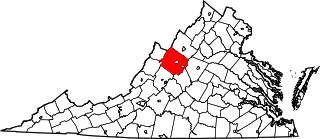
The Battle of Piedmont was fought June 5, 1864, in the village of Piedmont, Augusta County, Virginia. Union Maj. Gen. David Hunter engaged Confederates under Brig. Gen. William E. "Grumble" Jones north of Piedmont. After severe fighting, Jones was killed and the Confederates were routed. Hunter occupied Staunton on June 6 and soon began to advance on Lynchburg, destroying military stores and public property in his wake.
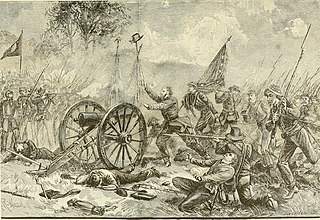
Pickett's Charge was an infantry assault ordered by Confederate Gen. Robert E. Lee against Maj. Gen. George G. Meade's Union positions on July 3, 1863, the last day of the Battle of Gettysburg in the state of Pennsylvania during the American Civil War.

The Third Battle of Winchester, also known as the Battle of Opequon or Battle of Opequon Creek, was an American Civil War battle fought near Winchester, Virginia, on September 19, 1864. Union Army Major General Philip Sheridan defeated Confederate Army Lieutenant General Jubal Early in one of the largest, bloodiest, and most important battles in the Shenandoah Valley. Among the 5,000 Union casualties were one general killed and three wounded. The casualty rate for the Confederates was high: about 4,000 of 15,500. Two Confederate generals were killed and four were wounded. Participants in the battle included two future presidents of the United States, two future governors of Virginia, a former vice president of the United States, and a colonel whose grandson became a famous general in World War II.
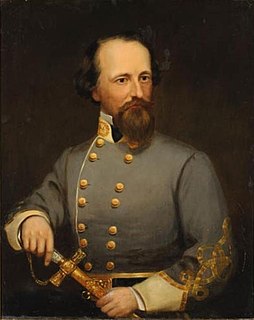
James Johnston Pettigrew was an American author, lawyer, and soldier. He served in the army of the Confederate States of America, fighting in the 1862 Peninsula Campaign and played a prominent role in the Battle of Gettysburg. Despite starting the Gettysburg Campaign commanding a brigade, Pettigrew took over command of his division after the division's original commander Henry Heth was wounded. In this role, Pettigrew was one of three division commanders in the disastrous assault known as Pickett's Charge on the final day of Gettysburg. He was badly wounded during the assault and was later mortally wounded during a Union attack while the Confederates retreated to Virginia near Falling Waters, West Virginia, dying several days later.

Hugh Judson Kilpatrick was an officer in the Union Army during the American Civil War, achieving the rank of brevet major general. He was later the United States Minister to Chile and an unsuccessful candidate for the U.S. House of Representatives.
The Stonewall Brigade of the Confederate Army during the American Civil War, was a famous combat unit in United States military history. It was trained and first led by General Thomas J. "Stonewall" Jackson, a professor from Virginia Military Institute (VMI). His severe training program and ascetic standards of military discipline turned enthusiastic but raw recruits into an effective military organization, which distinguished itself from the First Battle of Bull Run in 1861 to Spotsylvania Court House in 1864. Its legacy lives on in the 116th Infantry Brigade, which bears the unofficial nickname "Stonewall Brigade," and in several living history reenactment groups.
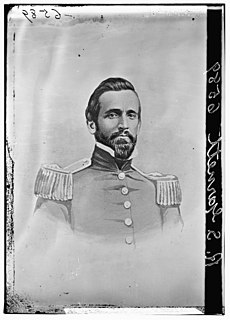
Richard Brooke Garnett was a career United States Army officer and a Confederate general in the American Civil War. He was court-martialed by Stonewall Jackson for his actions in command of the Stonewall Brigade at the First Battle of Kernstown, and killed during Pickett's Charge at the Battle of Gettysburg.

James Lawson Kemper was a lawyer, a Confederate general in the American Civil War, and the 37th Governor of Virginia. He was the youngest brigade commander and only non-professional military officer in the division that led Pickett's Charge, during which he was severely wounded.

Alexander Hays was a Union Army general in the American Civil War, killed in the Battle of the Wilderness.

A brigade major was the chief of staff of a brigade in the British Army. He most commonly held the rank of major, although the appointment was also held by captains, and was head of the brigade's "G - Operations and Intelligence" section directly, and oversaw the two other branches, "A – Administration" and "Q – Quartermaster". Intentionally ranked lower than the lieutenant colonels commanding the brigade's combat battalions, his role was to expand on, detail and execute the intentions of the commanding brigadier.
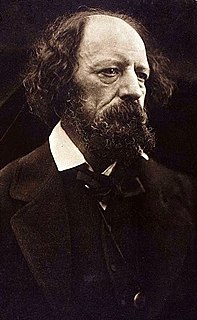
"The Charge of the Light Brigade" is an 1854 narrative poem by Alfred, Lord Tennyson about the Charge of the Light Brigade at the Battle of Balaclava during the Crimean War. He wrote it on 2 December 1854, and it was published on 9 December 1854 in The Examiner. He was the Poet Laureate of the United Kingdom at the time.
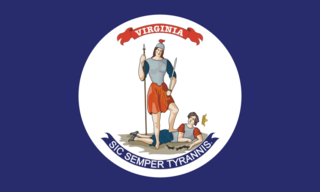
The 33rd Virginia Infantry Regiment was an infantry regiment raised in the Commonwealth of Virginia for service in the Confederate States Army during the American Civil War. It was a part of the famed "Stonewall Brigade," named for General Stonewall Jackson.

An ampere hour or amp hour is a unit of electric charge, having dimensions of electric current multiplied by time, equal to the charge transferred by a steady current of one ampere flowing for one hour, or 3,600 coulombs.

The 1st West Virginia Cavalry Regiment served in the Union Army during the American Civil War. Although it started slowly, it became one of the most active and effective of the West Virginia Civil War regiments—and had 14 Medal of Honor recipients, the most for any West Virginia regiment during the war. It was originally called the 1st Virginia Cavalry, not to be confused with the Confederate 1st Virginia Cavalry. Some reports added "Union," "Loyal" or "West" when identifying this regiment. After the Unionist state of West Virginia was officially admitted to the Union in 1863, the regiment became the 1st West Virginia Cavalry Regiment. The National Park Service identifies it as the 1st Regiment, West Virginia Cavalry.
The Longest Day of Nelson was conceived in 1980, when a group of racing enthusiasts, led by John McGill, Grover Griggs and Ann McHugh, came up with the idea to hold an amateur 24-hour endurance race for purely showroom stock vehicles at the Nelson Ledges Road Course in Ohio, which would take place on or near the summer solstice each year. Sanctioned by the Sports Car Club of America (SCCA), the host of the event was the Northeast Ohio Region of the SCCA.

The 12 Hours at the Point was an endurance race for sports cars and sedans hosted by the Washington, D.C. Region of the Sports Car Club of America (SCCA). The initial event was staged in June 1999 at Summit Point Motorsports Park in Summit Point, West Virginia. With the exception of 2006, the race has been held on the weekend closest to June 1. It is the oldest perennial SCCA-sanctioned endurance race.

James Keith "Jimmy" Marshall was a Confederate Army officer during the American Civil War. Marshall commanded the wounded J. Johnston Pettigrew's brigade during Pickett's Charge at the Battle of Gettysburg and died during the assault.
Todd Lamb is a professional American race car driver, Engineer, and Entrepreneur. He previously lived in Royal Oak, Michigan and currently resides in Atlanta, Georgia.

The Battle of Malvern Hill, also known as the Battle of Poindexter's Farm, was fought on July 1, 1862, between the Confederate Army of Northern Virginia, led by Gen. Robert E. Lee, and the Union Army of the Potomac under Maj. Gen. George B. McClellan. It was the final battle of the Seven Days Battles during the American Civil War, taking place on a 130-foot (40 m) elevation of land known as Malvern Hill, near the Confederate capital of Richmond, Virginia and just one mile (1.6 km) from the James River. Including inactive reserves, more than fifty thousand soldiers from each side took part, using more than two hundred pieces of artillery and three warships.
References
- 1 2 "What's Happening At VIR This Season". Roadracing World Magazine | Motorcycle Riding, Racing & Tech News. 2006-02-09. Retrieved 2020-02-29.